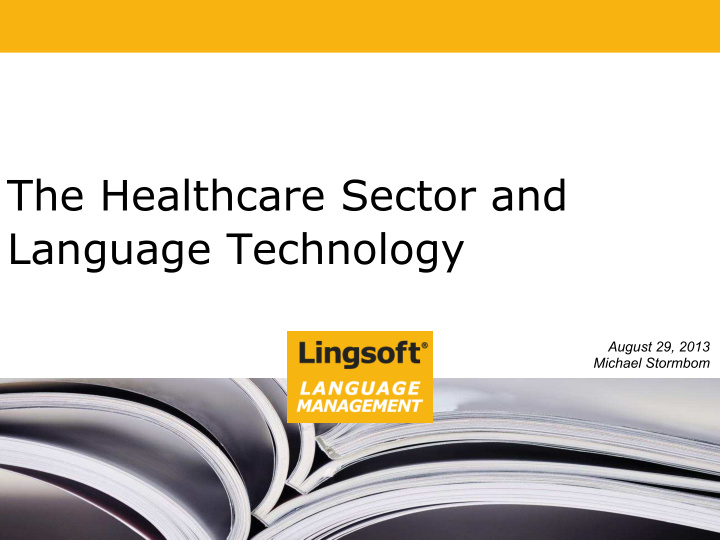



The Healthcare Sector and Language Technology August 29, 2013 Michael Stormbom
Language Services International full service language company Leading language technology Services designed for analysis, processing and utilisation of written and spoken language
Contents The Healthcare Sector Challenges and Requirements Medical Language Case Study: Medical Transcription and LT
The Healthcare Sector ● Healthcare sector one of the largest industries in the world ○ More than 10% of GDP in many developed nations ● More than 25 million people directly employed worldwide ● Various organisations, institutions and companies ○ Healthcare providers ○ Support and management ○ Administration ○ Technology ○ Pharmaceutical ○ ...
The Healthcare Sector
Spending Drivers ● Life expectancy ○ At the beginning of the 20th century: 30 years ○ 2010 average: 67 years ● Age distribution ● Lifestyle ○ Sedentary ○ Diet ○ Stress
Challenges ● Human resources ○ Labour migration ○ Increasing needs for eg. nurses ● Patient safety ○ “To err is human, but to really screw up you need a computer” ○ Therac-25 ● Cost control
Multilingualism ● Multilingualism ○ Free mobility within EU ○ Many countries have several official languages ○ Patients, doctors, nurses may speak different languages ● Crossborder cooperation ○ Directive 2011/24/EU on patients' rights in cross- border healthcare ○ eHealth interoperability framework Medical tourism ● Translation and interpretation needs
Challenges ● Cross-organisation data sharing needs ● Standardisation ○ A large set of different standards ○ Various stages of adoption ○ Legacy data ○ Terminologies and classification
Standards ● ICD-10 ○ Diagnosis classification maintained by WHO ○ Hierarchical structure ○ “ B30.0+H19.2 Keratoconjunctivitis due to adenovirus” ○ ICD-11 exp. 2015 ● ATC ○ Drug classification maintained by WHO ○ “A01AA02 sodium monophluorophosphate”
Layman Comprehension ● Patients have the rights to see their records ● Difficult to comprehend without significant domain knowledge ● Translating very domain-specific and incomprehensible language into “plain English“ ● Simultaneous translation into multiple languages
Medical Language ● In Finland (pop. 5.4 mil) on a yearly basis: ○ Six million polyclinic visits ○ One million hospital visits ○ One million private healthcare visits ○ All of which are to be documented ● Mostly in Finnish, occasionally in Swedish ● Patient journals ● Compactness and speed ● Standards (ICD-10)
Finnish and Swedish ● Finnish ○ Finno-ugric language ○ Agglutinative ○ Extensive case system ○ Complex morphology ○ Rich in inflections ● Swedish ○ Germanic language ○ Limited inflections
Medical Language ● Finite verbs and subjects absent ● Finnish: Verenpaine alhainen. [The patient’s] bloodpressure [is] low. Swedish: Lågt blodtryck. [The patient] [has] low bloodpressure. ● Non-informative parts omitted Swedish: det with impersonal verbs ( det regnar, it rains ) ● Joku on tehnyt jotakin à Joku tehnyt jotakin Someone has done something à Someone done something
Medical Language ● Acronyms and numerical data in abundance ● Conjunctions replaced with commas ● Independent main clauses joined together with commas ● Latin and native terminology used interchangeably
Medical Language ● Finnish: Antikoagulaatiohoito aloitettu. Swedish: Antikoagulationsbehandlingen inledd. The anti-coagulation treatment [has been] started. ● Finnish: Free word order ○ Pöydällä on kirja. There is a book on the table. ○ Kirja on pöydällä. The book is on the table. ○ Interchangeable in medical text ● Subordinate clauses infrequent
Workflows ● By leveraging language technology, workflows and process can be optimised ● Different LT used in different parts of the workflow ● Reducing manual labour ● Allowing LSPs to provide more efficient and less labour-intensive services ○ Larger volumes and lower unit cost
Medical Transcription Workflow
Medical Transcription Workflow ● Feedback loop ○ Coverage continuously improved ○ Terminologies to speller and predictive typing ○ Supporting morphological and syntactical analysis ● The role of the transcriber ○ Transcription ○ Post-editing and correction ○ Feedback
Speech Recognition ● Medical domain language model ● Recording quality and devices ○ Hospital infrastructure ● Pronunciation ○ Non-native speakers ● Post-processing (capitalization, punctuation, numbers in the right case)
Terminology Management ● Terminology checks ● Lookup and research tool ○ Eg. ICD-10 codes ○ Synonyms ● Multiword expressions ● Multilingual terminologies ● Central repository for vocabularies
Spell and Grammar Checking ● Correct language includes correct spelling and grammar ○ Deliberately ungrammatical ● Context-sensitive spell checking Their is a house ● False positives ○ Domain vocabulary ● Predictive typing for eg. ICD-10
Machine Translation ● Level of urgency ○ Translations may be needed rapidly at any time during the day ● Accuracy ○ Exact information needs to be conveyed ● With human post-editing or verification ● GF Demo
Grammatical Framework ● Standard RGLs ○ Ungrammatical structures ● Pre- and postprocessing ○ Punctuation, abbreviation consistency Spelling errors in source ● Lexical resources, medical FIN and SWE ○ ICD-10, ATC ● Iterative approach
Conclusions ● The healthcare sector is facing many challenges ● Leveraging LT will be an important aspect in overcoming those challenges ● In particular multilingual LT is becoming increasingly important
Sources http://www.oecd.org/health/health-systems/ oecdhealthdata.htm http://www.corepointhealth.com/sites/default/ files/whitepapers/hl7-history-v2-v3.pdf http://www.who.int/classifications/icd/en/ http://sydney.edu.au/medicine/fmrc/atc/ http://www.iso.org/iso/products/ standards/catalogue_ics_browse.htm? ICS1=35&ICS2=240&ICS3=80& Vainikainen, Kirsi, Klinisk minilekt i elektroniska patientjournaler, University of Turku 2010
Thank you! www.lingsoft.fi info@lingsoft.fi @lingsoft slideshare.net/lingsoft
Recommend
More recommend